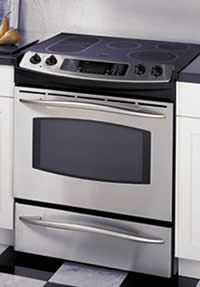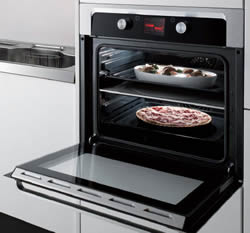Difference between Conventional Oven and Convection Oven
Key Difference: Conventional ovens are basically ovens that use gas, wood or electricity for power. These are ovens that we often find in many homes that are used for cooking. Convection ovens are actually ovens similar to the original ones with an extra feature, fans. The only major difference between the conventional ovens and convection ovens are the fans.
Ovens have been in existence since the discovery of fire. They play an important part to our livelihood and well-being. There are various different kinds of ovens that are available in the market that makes it easier to cook, heat up food and various other things. Ovens are also used for other purposes such as glass-making, forging, ceramic making, creating heat, etc. Conventional oven and convection ovens differ from each other in its ability to provide a more even heat. Convection ovens come with attached fans that allow heat to be spread more evenly throughout the oven, while conventional ovens lack this feature.
 Conventional ovens does not have a proper set definition, still it is found in many food packages that require to be heated in the ovens. Ever notice the ‘Use in Conventional oven’ or ‘Conventional oven only’ on the package of a food product. Well, conventional ovens are the traditional gas, stove and electric ovens that are found in everyone’s kitchen. These ovens are often huge and some may even come attached with a stove. These ovens are used for cooking, roasting and heating. Foods that are cooked in conventional ovens include meat, casseroles, lasagna, baked products (bread, cake, cookies, cupcakes, etc.)
Conventional ovens does not have a proper set definition, still it is found in many food packages that require to be heated in the ovens. Ever notice the ‘Use in Conventional oven’ or ‘Conventional oven only’ on the package of a food product. Well, conventional ovens are the traditional gas, stove and electric ovens that are found in everyone’s kitchen. These ovens are often huge and some may even come attached with a stove. These ovens are used for cooking, roasting and heating. Foods that are cooked in conventional ovens include meat, casseroles, lasagna, baked products (bread, cake, cookies, cupcakes, etc.)
Conventional ovens can or cannot be controlled depending on the complexity or simplicity of the oven. Simple ovens may not have any other controls other than on and off, with a timer. More complex ovens are available with timers, temperature controls, special modes for different types of cooking, and automatic off feature. These vary depending on the make and the type of oven that is available. Conventional ovens provide the heat for cooking from below, while the more new ones also provide heat from the top. However, one main difference that sets conventional ovens apart is that it is not have fans. This is considered one of the biggest differences from convection ovens. Convections ovens have fans to properly regulate temperature and properly distribute heat. Conventional ovens lack this feature; however, they are considered the best appliance for baking and broiling.
 Convection ovens are actually ovens similar to the original ones with an extra feature, fans. The only major difference between the conventional ovens and convection ovens are the fans. Convection ovens are also powered by gas or electricity. The fans allow the heat provided by the gas burners or electric coils to circulate throughout the enclosed space. Convection style cooking was discovered in the 1960s, but did not gain popularity until recently.
Convection ovens are actually ovens similar to the original ones with an extra feature, fans. The only major difference between the conventional ovens and convection ovens are the fans. Convection ovens are also powered by gas or electricity. The fans allow the heat provided by the gas burners or electric coils to circulate throughout the enclosed space. Convection style cooking was discovered in the 1960s, but did not gain popularity until recently.
The purpose of installing fans in the convection ovens is to allow the fans to push the air to all the parts of oven creating a stable temperature for even cooking. Convection ovens have been known to provide a more even cooking, along with having the ability to retain juices when roasting meat. The even cooking and temperature reduces the cooking time, allowing the food to cook faster and saves electricity or gas. However, it has said to dry out baked goods such as cookies, bread and cake. Today, convection ovens are available as an added feature to normal gas, electric or microwave ovens.
|
|
Conventional Oven |
Convection Ovens |
|
Runs on |
Electricity, natural gas (propane, butane, LPG), wood, etc. |
Gas or electric |
|
Price |
The price of the oven depends on initial set up charges and what it runs on. |
Convection ovens are more costly compared to normal ones; especially if they come as a feature included in gas and electric ovens. |
|
Heating |
Heating depends on the type of oven. While gas ovens heat up fast, electric ovens take a while in order to heat up. |
Convection ovens are powered by fans which help circulate hot air throughout the oven, causing it to heat faster and provide a more even cooking. |
|
Cooking Time |
Cooking time is greater in conventional ovens. |
Cooking time is reduced due to air flow. |
|
Economical |
In the long run, it depends on the type of ovens. Gas ovens are commonly more economic in the long run. Electric ovens are more costly in the long run as electricity is more costly compared to natural gas. |
In the long run convection ovens are better as they reduce the cooking time and save on energy and natural gas bills. |
|
Heat distribution |
Gas ovens distribute heat unevenly (more heat from top), while electric ovens have a more even heat distribution. |
A more even heat distribution as the fans allow the hot air to travel in all directions in the oven. |
|
Temperature Management |
Temperature is fairly to manage in almost all off the ovens. |
Temperature is really easy to manage as the fans automatically manage the set temperature. |
|
Burners |
Runs on burners, coils, wood, coal, etc. |
Runs on burners, or electric coils. |
|
Benefits |
The benefit of each oven depends on the type of oven it is. While electric ovens are easier to clean and cheaper to install; gas ovens are faster to heat up and are cheaper in the long run. |
Convection ovens are more economical in the long run, have a more even heating, reduces the cooking time and has an option to switch back to conventional oven setting. |
|
Limitations |
Electric: expensive in the long run, slow heating, useless during power outage; Gas: harder to clean, expensive repairs, danger of leakage, expensive installation. |
Expensive to purchase, not good for baking goods that require moisture. In case adhering to a certain recipe the temperature will need to be adjusted according to convection oven. |
Image Courtesy: homeappliances.wordpress.com, appliancist.com









Add new comment